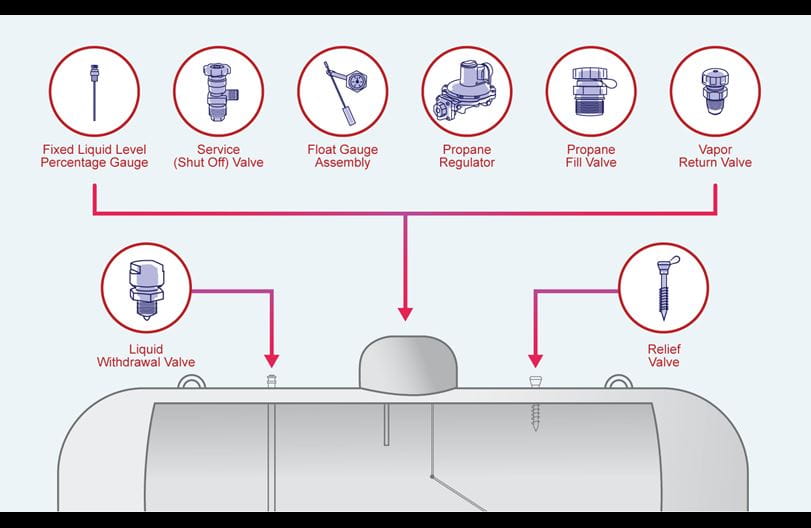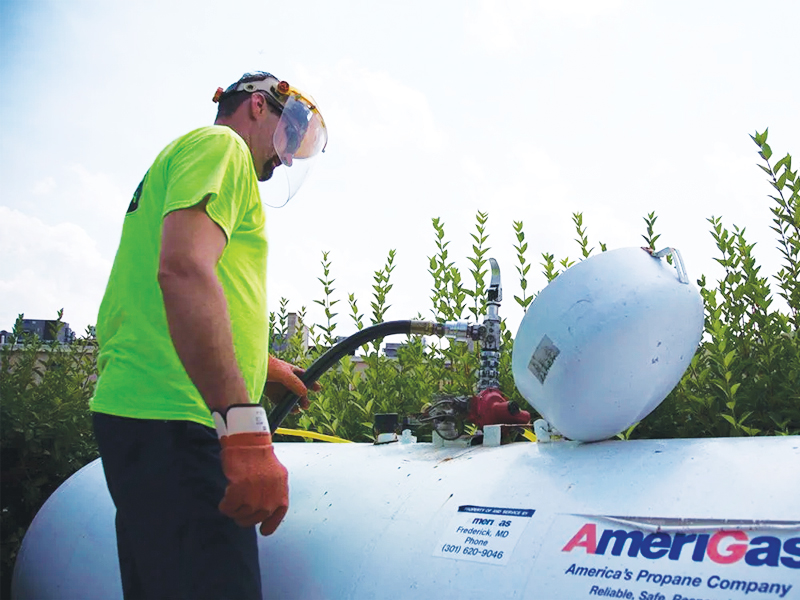Everything you need to know to keep an eye on your backyard or underground propane tank and its parts.
Gauges, regulators, valves … welcome to your propane tank! If you’ve only used propane to power a gas grill in the past, the larger tanks may be intimidating. It can seem like a whole new world at first, especially if you’re used to powering your home using other fuel sources like natural gas, whose components may not be as visible. And while your propane supplier often handles a lot of the periodic propane tank maintenance and refilling, it’s a great idea to know the basics — especially if you own your own tank. No worries — we’ll make it easy for you. So you can feel confident and secure managing the day-to-day operations of living with propane.
Here’s a quick glossary of propane tank parts along with their functions — plus a few tips for making sure your propane tank stays in good working order.

Let’s start with the basic tank components. Each of these, shown in the diagrams above, is found on every propane tank:
Propane Fill Valve: When your propane is delivered, this is the valve that the technician attaches to the fuel hose. The hose from the truck connects to this valve. The hose end coupling screws into the valve with a gasket to create a reliable seal that prevents gas from escaping.
Service (Shut Off) Valve: Essentially the master switch to the propane supply, the service valve is the point at which propane gas enters the piping system to supply all the appliances that connect to it.
Float Gauge Assembly: The float gauge shows the volume of propane in the tank. Sometimes called a dial gauge, the float gauge is made of several parts: a mechanical float that lives inside the tank (much like the float you’d see if you lift the lid off your toilet’s water tank) connected to a reader on the outside of the tank that displays the liquid level (this may be a numeric gauge or a visual one color coding for safe, under-, and over-fill levels). It doesn’t show the exact amount of liquid in the tank, but it is reliable for everyday monitoring of your tank’s propane level.
HOW TO READ YOUR FLOAT GAUGE
To check the approximate propane level in your tank, look at the float gauge. It will be a round (or roundish) device on the tank (see image above) with a needle over a range of numbers or graphic indicators. The numbers will range from 5 to 95 — indicating a percentage of volume, not the number of gallons remaining. If you see a level below 30, it means that your tank is getting low and needs to be refilled.
If it’s above 80, it’s over-filled. Move away from the tank, and keep everyone away in case it opens. Call your supplier immediately.
If you’re an AmeriGas customer, you may also have a remote tank monitor that automatically transmits the tank’s percentage to us every day. You can check your tank’s current status — without looking at your tank — by logging into your AmeriGas account. Learn more about our online services.
Relief Valve: This is the safety relief mechanism designed to vent propane in the event that pressure builds — for example, if the heat rises very suddenly to an extreme temperature (as might happen in a forest fire or other emergency situation). A spring inside the valve is designed to release if the pressure inside the tank builds to a certain level, at which point the valve will open slightly and start to hiss. If pressure rises excessively, the valve will open completely. The relief valve allows pressure to be released quickly and safely. All propane tanks are required by law to have a relief valve. You may also hear it called a pop-off valve or a pressure-venting valve.
Fixed Liquid Level Gauge: Also known simply as a fixed liquid level gauge or the bleeder valve, this is the only tank component that gives a precise measure of how much liquid propane is in the tank. It’s used only by certified propane service providers when filling the tank — and even then, it’s used only to monitor, not to refill (propane goes into the tank through the fill valve).
Vapor Return Valve: Also known as the vapor equalizing connection or vapor equalization valve, this feature is required on all ASME propane tanks. They are usually deployed in the event that the liquid in the container becomes very overheated and must be evacuated from the container.
Liquid Withdrawal Valve: Used by technicians to withdraw liquid propane from the tank so it can be moved or disposed of. Note: Never attempt to remove liquid propane from a tank on your own. This should only be done by a professional using specialized equipment.
Propane Regulator: Though they come in many shapes and sizes, the function of all propane regulators is the same — they maintain a safe and effective level of pressure on propane within the tank. This helps keep the flow steady and usable. These components make a persistent humming noise when operating — don’t worry, it’s normal.
Now that you know the basics…
You’re aware of what your tank should look like when it’s “all systems go” — as well as some important warning signs that will tell you it’s time to contact a professional. Armed with these basic terms and tips, you’re set up for propane success.
Safety Note: We do not recommend attempting any propane system adjustments, repairs, or maintenance on your own. Only certified propane professionals are equipped with the gear and knowledge to properly assess and address propane systems safely. Please contact us for more information and service.
Still have questions about your propane tank?
Please contact us for more information and service.
Residential Propane Go to blog list page filtered for the category

